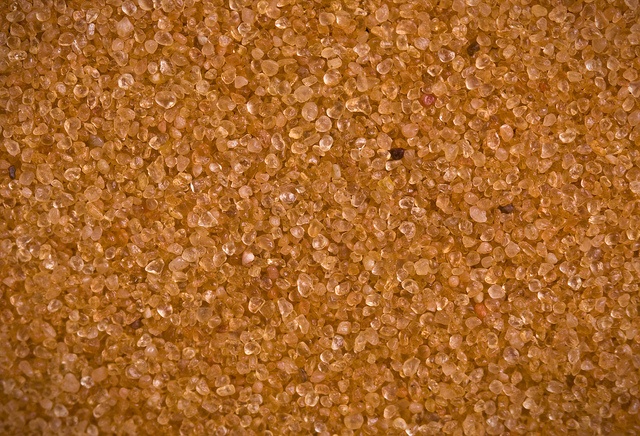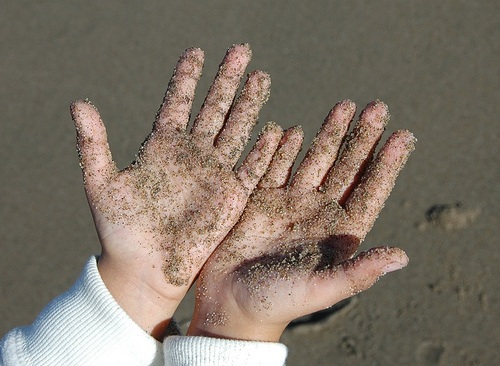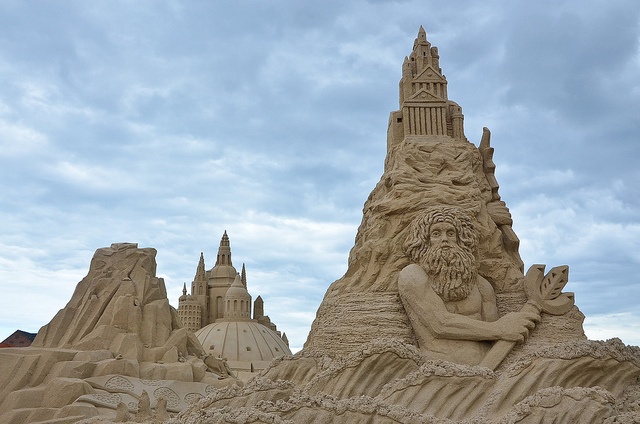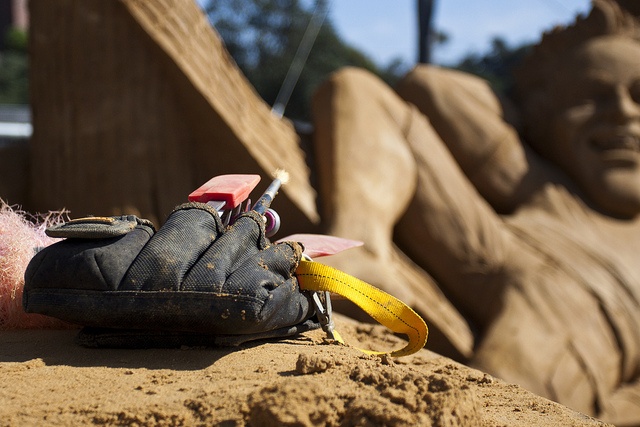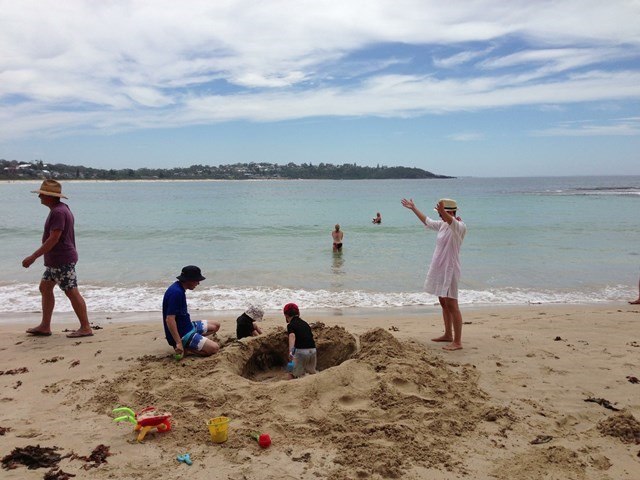Build it up—making the perfect sandcastle
Expert reviewers
Essentials
- Combining one part water with 99 parts dry sand gives you the best chance of building the most stable sandcastle.
- Sand with rougher, jagged edges is better for making sandcastles than smooth beach sand.
- The world’s tallest sandcastle was 13.97 metres high.
- By studying sandcastles we can better understand fields as diverse as civil engineering, physics and soil mechanics.
- The maximum height of a sandcastle varies with its width.
Almost everyone loves a trip to the beach. The sun, the surf… the sandcastles! From planning and construction through to decoration and inevitable destruction, there is real skill involved in making the perfect sandcastle ... and also real science.
For Ted Siebert, building sandcastles is serious business. After all, he’s the current Guinness World Record holder for the world’s tallest sandcastle (13.97 metres). His impressive creation required 1,800 tonnes of imported sand, and took a team of 19 people two weeks to complete. Most of us aren’t trying to break any records, happy to toil away with a simple bucket and spade, but if you’re trying to make the perfect sandcastle this Christmas, read on.
What is sand?
Sand is a naturally occurring granular material composed of fine mineral particles weathered from rocks or broken shells.
The most common component of beach sand is silicon dioxide (SiO2) in the form of quartz (as it’s one of the more common minerals and is also quite hard). But sand’s composition, colour and consistency can change dramatically depending on the place (beach, riverbed or desert), and even the country, it comes from, as well as the local rock sources and conditions. When looked at under the microscope, sand isn’t only an incredible thing, it’s a bunch of tiny little everything—from the shells of sea creatures (calcium carbonate, most often white or pale yellow), to organic fragmental material, to coral, volcanic particles (usually black), bits of minerals, glass or bone. Nobody knows exactly how many different types of sand there are, as there is no official sand classification table, however, there are at least 100.
Sand refers to a grain size. As defined by geologists, sand particles range from 0.0625 millimetres (approximately one-sixteenth of a millimetre), up to 2 millimetres. Larger particles are classed as gravel, while smaller particles are known as clay or silt. If you’re unsure, rub some between your fingers―sand feels gritty, while silt feels more like flour.
While you can make a sandcastle out of almost any kind of sand, to make the perfect sandcastle you need the right type.
Former sandcastle world-record holder Ed Jarrett studied the different types of sand to find the sort best suited to making award-winning sandcastles. He found that beach sand generally has round edges, due to being worn down by waves and, before that, from being transported down rivers before it reaches the sea. When he studied sand formed by glacial activity, however, he noted that it had rough, sharp edges. This was because it had been ground by huge ice sheets moving over it, and also because it had not been transported very far. These rough edges catch against each other, creating friction that helps to hold up a sand structure. As a result, Jarrett (and many other sand-sculptors) truck in their own sand from external areas rather than use the sand on the beach where they’re creating their castles.
Another hint: when you choose your sand, take a small portion of it and place it in a bucket with water. The best sand for building your sandcastle is that which doesn’t contain any finer clay material. If there is clay, the water may become murky. This is a good clue to help you decide whether to discard that sand.
Getting the sand-to-water ratio correct
A sandcastle without water is just a pile of loose sand. But how much water is the right amount? Too little and your construction crumbles. Too much and your sand becomes a gloopy mess.
Luckily, scientists have been on the case, working hard to solve this delicate engineering problem for you. While traditional estimates put the ratio at one bucket of water for every eight buckets of sand (or 12.5 per cent water), new research has revised the amount of liquid down to just 1 per cent.
Daniel Bonn and his team at the Laboratory of Physical Statistics in Paris conducted a series of experiments involving both the theoretical and practical modelling of sandcastles.
Their studies involved testing different levels of sand ‘wetness’ and examining how columns of sand collapsed as they were built higher and higher. The results, published in Nature found that there is an optimum sand wetness level: beachgoers should be aiming for a liquid volume of 1 per cent. It may not seem like much, but by combining one part water with 99 parts dry sand, you are giving yourself the best chance of building the perfect, most stable sandcastle. The team concluded that ‘if this optimum concentration is used, sandcastles reaching five metres in height can be built.’
When sand is wet, water forms small bridges (shaped like a double-ended trumpet) between the grains of sand. The surface tension of the water will then pull the grains together, so that they are effectively connected by a series of meniscus bridges—this is what gives wet sand its strength. When enough of these bridges form, the mixture is able to hold its shape, enabling the creation of complex structures such as sandcastles.
You might assume that the more water you add, the more bridges are formed, therefore increasing the strength of the sand, but this was true only up to about 1 per cent water. Beyond this point, the bridges of water got close enough together that they started to merge, forming bigger bridges and blobs of water. The small bridges are stronger than these larger blobs, so increasing the water beyond the 1 per cent mark does not lead to a change of coherency—in fact, the castle will be weakened if too much water is applied.
If studying sandcastles sounds trivial, consider this. The results of studies like this could be applied to many different fields including civil engineering, physics and soil mechanics. For example, by better understanding liquids and granular materials, we can improve our understanding of other mixing processes. The findings may help determine the stability of retaining walls and the material they hold back, and even the critical point at which a combination of mud and water can become a landslide.
 opener
opener
Image source: Aerial view of west end of the landslide burying the highway and damming the Naches River. Image source: Washington State Department of Transport / Flickr.
Bucket, spade, or your own two hands?
So, we know the type of sand we need to use, and the sand-to-water ratio we should be aiming for. But what tools do we need? Plastic bucket? High-quality spade? Not according to physicists, who, after conducting a series of experiments, concluded that your hands are the best tools for the job.
Compaction is essential for a sturdy sandcastle, with a well-packed castle up to 30 per cent stronger than one that is more loosely built. By compacting the sand as much as possible, you shorten the molecular water bridges, making the sand stronger. While you can compress sand in a bucket, it loses much of its strength and compaction when it is tipped out. Using a spade can produce an uneven result and, according to the authors of the study, it ‘tends to introduce fractures in the sand’s structure rather than compact it’.
Your hands give you a lot more control over the amount of pressure you exert and how you mould the sand, making them the perfect building tool. The physicists did note, however, that it would be wise to use buckets and spades to collect the sand, do the heavy lifting and make the first mound. You should use your hands to compact the sand and carve away the excess until you’ve created the masterpiece of your sandcastle dreams.
Just a little more—how high can you go?
Even with the best sand, the perfect sand-to-water ratio and the most capable hands in the world, there is another aspect affecting the creation of the perfect sandcastle—the height-to-radius ratio. The same team who discovered the 1:99 ratio also found that the maximum height of a sandcastle varies with its width.
Interestingly, they found that the height-to-radius ratio decreases the wider you make your column. So a wider, bigger base won’t give you additional stability to build up extra height, at least past a certain point. Using typical beach sand, the team found that by building a cylinder with a base radius of only 20 centimetres, they could reach a height of 2.5 metres—an impressive sandcastle in anyone’s books.
Any other tips?
Science can play a big part in helping us create the ultimate sandcastle, but there’s a bit of common sense involved too. Here are some tips:
- Choose the location. It’s important to find the perfect spot on the beach before you start building. Too close to the water and the waves will soon reduce your masterpiece to nothing, washing away all your hard work. Too far away and you’re creating extra work for yourself as you’ll have to make repeated trips to the surf to get water and wet sand. Aim for a place that has damp (but not wet) sand, isn’t in a high-traffic area, and isn’t likely to be reached by waves.
- Don’t dig a moat. It might seem like a good idea in theory—a barrier to collect any water that may rush in (and to protect your castle from invaders)—but, if dug too close to your castle, a moat can weaken your structure, as the sand around it collects excess water.
- Keep it moist. If you’re building something big, you don’t want it to dry out before you’ve finished. You can keep your castle moist with a spray bottle.
- Use proper tools. If you’re planning on adding intricate carvings and embellishments to your creation, make sure you invest in some good tools. These can be found in almost any kitchen drawer or garage toolbox―kitchen knife, putty knife, paint scraper, trowel, soft-bristled paintbrush, even a plastic drinking straw or two.
Conclusion
Building a sandcastle is always fun but, as science has shown, it’s not just child’s play. By studying how and why sandcastles hold together, and how and when they collapse, we can better understand fields as diverse as civil engineering, physics and soil mechanics, among others. Perhaps even more importantly, we can use that knowledge to impress our friends and family this summer as we create tall, stable and beautiful sandcastles. Happy building!






